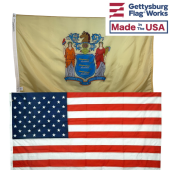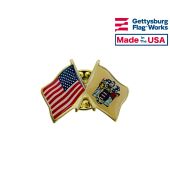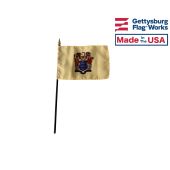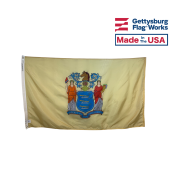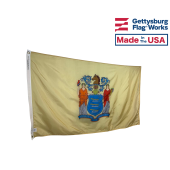New Jersey State Flag
- New Jersey & Battle-Tough® American Flag Combo PackStarting at $69.95
-
-
-
Flag of New Jersey
The New Jersey State flag can trace its history back to the Revolutionary War. New Jersey has the rare honor of being able to say that George Washington was responsible for part of the flag's design, which has ensured that the design has remained relatively stable over the years.
Colors and Symbolism of the NJ State Flag
The NJ state flag features the state's coat of arms in the center of a buff field. The buff field originated during the Revolutionary War, and it remains as part of the state flag as a reference to New Jersey's history. It was originally selected to represent New Jersey during the war as a symbol of the Dutch colonists who had initially settled in the region, so it reflects the state's ethnic heritage in addition to its role in the American revolution. The coat of arms consists of a blue shield with three plows that is supported by two women in classical costumes and crowned by a helmet that is topped with a horse's head. The motto of New Jersey is displayed below the shield. The plows represent the state's agriculture, while the women represent Liberty and a Roman agricultural goddess named Ceres. They are a reference to the state's motto, "Liberty and Prosperity."
History of the New Jersey State Flag
The flag of New Jersey began during the Revolutionary War. Regiments in the revolutionary army carried both national flags and regimental flags that featured their state's identifying color, which was a buff flag for New Jersey. The regimental flag served as an unofficial NJ state flag for many years before it received official approval by a state government.
The military flag was adapted to create a civilian flag of New Jersey in 1896. The buff field was retained in order to honor the state's revolutionary soldiers, but the state's coat of arms was added to the center of the flag to make sure that people recognized the flag as a symbol of New Jersey. The design was popular, and no significant changes have ever been made. The specific shades to be used on the flag were defined in 1965, but the new definition served to standardize all of the flags that were in use rather than to make any changes to the New Jersey state flag.
A short history of the New Jersey State flag
New Jersey was one of the 13 original states, and disposed of all signs of British royal dominance in 1776. The seal was designed by Eugene de Simitiere, and was made up of a coat of arms. The blue shield containing three ploughs illustrated the importance of agriculture to the state economy. The supporters are Liberty on the left, and Ceres, the Roman goddess of agriculture, and the crest is an armored helmet toped by a horse's head. The colors and the details to be used were not officially regulated until 1928. It was at this time when the scroll was added and the date changed to Arabic figures. In March 1898 the arms were placed on the buff background to serve as a flag for the state governor and the commander-in-chief of the state militia. The flag was in general use by the public in the 1930's, and the usage was legalized in 1938.
A short history of New Jersey (The Garden State)
New Jersey has an extensive agricultural base, and strong industrial activity. First settled by the Dutch in 1623. It became an English colony in 1664, and a royal province in 1702. In 1776 independent government was set up, and the state ratified the Constitution on December 18,1787.
Area of New Jersey: 7,787 sq. miles
Capital: Trenton
Major Products: chemicals, electronic and electrical equipment, machinery, tomatoes, corn, fruit
State Motto: Liberty and prosperity
